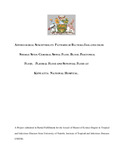| dc.contributor.author | Bwisa, Lavinia | |
| dc.date.accessioned | 2014-12-08T14:43:29Z | |
| dc.date.available | 2014-12-08T14:43:29Z | |
| dc.date.issued | 2014-12-08 | |
| dc.identifier.uri | http://hdl.handle.net/11295/76656 | |
| dc.description | Thesis Master of Science Degree in Tropical and Infectious Diseases | en_US |
| dc.description.abstract | Background. Antimicrobial resistance is dramatically increasing worldwide. Much of it due to
inappropriate overuse and is causing significant morbidity and mortality.
Diagnosis of sterile site infections is based on culture of properly collected and processed
samples. Since definitive diagnosis is based on quantitative cultures, the course of antibiotic
therapy should be determined after the culture results have been confirmed. Unfortunately in
most instances empiric treatment is commenced because it is not possible to wait for culture
reports or laboratory facilities are unavailable.
Infections caused by drug resistant organisms are difficult to eradicate because of limited
therapeutic options. With growing antimicrobial resistance in Kenya, reliance on international
guidelines is insufficient and hence a study such as this one is needed to get our local patterns to
help formulate local policies.
Objectives. The general objective of this study was to determine the bacterial isolates identified
from sterile body sites and their antibiotic susceptibility patterns from both inpatients and
outpatients at the Kenyatta National Hospital (KNH) microbiology laboratory, in the period
January to December 2013.
Study design and Methodology. This was a retrospective descriptive study done over three
months using previously available data from the patients’ laboratory files.
After obtaining ethical approval from the KNH/UON- ERC, abstraction of data of samples
collected from sterile sites was done from the existing laboratory database using a coded form,
which was then recorded on a tally sheet .The outcomes that were considered were bacterial
isolates from the respective sterile sites i.e. Cerebral Spinal Fluid (CSF), blood, peritoneal,
pleural and synovial fluid; and their antibiotic susceptibility patterns. Demographic | en_US |
| dc.language.iso | en | en_US |
| dc.subject | cerebral spinal fluid | en_US |
| dc.title | Antimicrobial susceptibility patterns of bacteria isolated from sterile sites: cerebral spinal fluid, blood, peritoneal fluid, pleural fluid and synovial fluid at Kenyatta National Hospital | en_US |
| dc.type | Thesis | en_US |
| dc.description.department | a
Department of Psychiatry, University of Nairobi, ; bDepartment of Mental Health, School of Medicine,
Moi University, Eldoret, Kenya | |
| dc.type.material | en_US | en_US |




